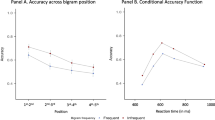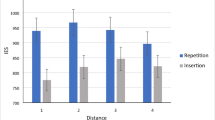Abstract
Pseudowords created by transposing two letters of words (e.g., MOHTER; CHOLOCATE) are highly confusable with their base word; this is known as the transposed-letter similarity effect. In this work, we examined whether transposed-letter effects occur when words span more than one line (e.g., CHOLO- in one line and CATE in another line; note that the transposed letters L and C are in different lines). While this type of presentation is not the canonical format for reading in alphabetic languages, it is widely used in advertising, billboards, and street signs. Transposed-letter pseudowords and their replacement-letter controls were written in the standard one-line format versus a two-line format (Experiments 1–2) or a syllable-per-line format (Experiment 3). While results showed some decrease in the transposed-letter effect in the two-line and syllabic formats, the transposed-letter effect was still substantial in the accuracy of responses. These findings demonstrate that even when the letters being transposed are relatively far apart in space, the transposed-letter effect is still robust. Thus, a major component of letter position coding occurs at an abstract level.









Similar content being viewed by others
References
Adelman, J. S. (2011). Letters in time and retinotopic space. Psychological Review, 118, 570–582. https://doi.org/10.1037/a0024811
Agrawal, A., Hari, K. V. S., & Arun, S. P. (2020). A compositional neural code in high-level visual cortex can explain jumbled word reading. eLife, 9, e54846. https://doi.org/10.7554/elife.54846
Baciero, A., Gómez, P., Duñabeitia, J. A., & Perea, M. (2022). Raeding with the fingres. Towards a universal model of letter position coding. Psychonomic Bulletin & Review. https://doi.org/10.3758/s13423-022-02078-0
Barr, D. J., Levy, R., Scheepers, C., & Tily, H. J. (2013). Random effects structure for confirmatory hypothesis testing: Keep it maximal. Journal of Memory and Language, 68, 255–278. https://doi.org/10.1016/j.jml.2012.11.001
Bonnet, C., & Dresp, B. (1993). A fast procedure for studying conditional accuracy functions. Behavior Research Methods, Instruments & Computers, 25, 2–8. https://doi.org/10.3758/BF03204443
Bruner, J. S., & O’Dowd, D. (1958). A note on the informativeness of parts of words. Language and Speech, 1, 98–101. https://doi.org/10.1177/002383095800100203
Brysbaert, M., & Stevens, M. (2018). Power analysis and effect size in mixed effects models: A tutorial. Journal of Cognition. https://doi.org/10.5334/joc.10
Bürkner, P.-C. (2016). brms: An R package for Bayesian multilevel models using Stan. Journal of Statistical Software, 80(1), 1–28. https://doi.org/10.18637/jss.v080.i01
De Jong, R., Liang, C. C., & Lauber, E. (1994). Conditional and unconditional automaticity: A dual-process model of effects of spatial stimulus-response correspondence. Journal of Experimental Psychology: Human Perception and Performance, 20(4), 731–750. https://doi.org/10.1037/0096-1523.20.4.731
Duchon, A., Perea, M., Sebastián-Gallés, N., Martí, A., & Carreiras, M. (2013). EsPal: One-stop shopping for Spanish word properties. Behavior Research Methods, 45, 1246–1258. https://doi.org/10.3758/s13428-013-0326-1
Estes, W. K. (1975). The locus of inferential and perceptual processes in letter identification. Journal of Experimental Psychology: General, 104, 122–145. https://doi.org/10.1037/0096-3445.104.2.122
Fernández-López, M., Marcet, A., & Perea, M. (2021). Does orthographic processing emerge rapidly after learning a new script? British Journal of Psychology, 112, 52–91. https://doi.org/10.1111/BJOP.12469
Forster, K. I., & Forster, J. C. (2003). DMDX: A Windows display program with millisecond accuracy. Behavior Research Methods, Instruments, & Computers, 35, 116–124. https://doi.org/10.3758/bf03195503
García-Orza, J., Perea, M., & Estudillo, A. (2011). Masked transposition effects for simple vs. complex non-alphanumeric objects. Attention, Perception & Psychophysics, 73, 2573–2582. https://doi.org/10.3758/s13414-011-0206-7
García-Orza, J., Perea, M., & Muñoz, S. (2010). Are transposition effects specific to letters? Quarterly Journal of Experimental Psychology, 63, 1603–1618. https://doi.org/10.1037/e520562012-240
Gómez, P., & Perea, M. (2013). From models to special populations. The case of the overlap model. Paper presented at the 11th International Symposium of Psycholinguistics, Tenerife, Spain.
Gómez, P., Marcet, A., & Perea, M. (2021). Are better young readers more likely to confuse their mother with their mohter? Quarterly Journal of Experimental Psychology, 74, 1542–1552. https://doi.org/10.1177/17470218211012960
Gómez, P., Ratcliff, R., & Perea, M. (2008). The overlap model: A model of letter position coding. Psychological Review, 115, 577–601. https://doi.org/10.1037/e512682013-035
Gómez, P., & Silins, S. (2012). Visual word recognition models should also be constrained by knowledge about the visual system. Behavioral and Brain Sciences, 35(5), 287. https://doi.org/10.1017/s0140525x12000179
Grainger, J. (2018). Orthographic processing: A “mid-level” vision of reading. Quarterly Journal of Experimental Psychology, 71, 335–359. https://doi.org/10.1080/17470218.2017.1314515
Grainger, J., & van Heuven, W. J. B. (2003). Modeling letter position coding in printed word perception. In P. Bonin (Ed.), Mental lexicon: Some words to talk about words (pp. 1–23). Nova Science Publishers.
Grainger, J., & Ziegler, J. C. (2011). A dual-route approach to orthographic processing. Frontiers in Psychology, 2, 54. https://doi.org/10.3389/fpsyg.2011.00054
Houghton, G. (2018). Action and perception in literacy: A common-code for spelling and reading. Psychological Review, 125, 83–116. https://doi.org/10.1037/rev0000084
Kinoshita, S., & Norris, D. (2013). Letter order is not coded by open bigrams. Journal of Memory and Language, 69, 135–150. https://doi.org/10.1016/j.jml.2013.03.003
Lee, C. L., & Estes, W. K. (1977). Order and position in primary memory for letter strings. Journal of Verbal Learning and Verbal Behavior, 16(4), 395–418. https://doi.org/10.1016/s0022-5371(77)80036-4
Lee, C. H., & Taft, M. (2009). Are onsets and codas important in processing letter position? A comparison of TL effects in English and Korean. Journal of Memory and Language, 60(4), 530–542. https://doi.org/10.1016/j.jml.2009.01.002
Logan, G. D. (1996). The CODE theory of visual attention: An integration of space-based and object-based attention. Psychological Review, 103, 603–649. https://doi.org/10.1037/0033-295x.103.4.603
Logan, G. D. (2021). Serial order in perception, memory, and action. Psychological Review, 128, 1–44. https://doi.org/10.1037/rev0000253
Marcet, A., Perea, M., Baciero, A., & Gómez, P. (2019). Can letter position encoding be modified by visual perceptual elements?. Quarterly Journal of Experimental Psychology, 72, 1344–1353. https://doi.org/10.1177/1747021818789876
Massol, S., Duñabeitia, J. A., Carreiras, M., & Grainger, J. (2013). Evidence for letter-specific position coding mechanisms. PLoS One, 8, e68460. https://doi.org/10.1371/journal.pone.0068
Massol, S., & Grainger, J. (2022). Effects of horizontal displacement and inter-character spacing on transposed-character effects in same-different matching. PLoS One, 17(3), e0265442. https://doi.org/10.1371/journal.pone.0265442
Mirault, J., Vandendaele, A., Pegado, F., & Grainger, J. (2022). Transposed-word effects when reading serially. Manuscript submitted for publication.
Norris, D., & Kinoshita, S. (2012). Reading through a noisy channel: Why there’s nothing special about the perception of orthography. Psychological Review, 119, 517–545. https://doi.org/10.1037/a0028450
Ollman, R. T. (1977). Choice reaction time and the problem of distinguishing task effects and strategic effects. In S. Dornic (Ed.), Attention and Performance 6 (pp. 99–113). Erlbaum.
Peirce, J. W., & MacAskill, M. R. (2018). Building experiments in PsychoPy. Sage.
Perea, M., Baciero, A., Marcet, A., Fernández-López, M., & Gómez, P. (2021). Do grading gray stimuli help to encode letter position? Vision, 5(1), 12. https://doi.org/10.3390/vision5010012
Perea, M., García-Chamorro, C., Centelles, A., & Jiménez, M. (2013). Position coding effects in a 2D scenario: The case of musical notation. Acta Psychologica, 143, 292–297. https://doi.org/10.1016/j.actpsy.2013.04.014
Perea, M., Jiménez, M., & Gómez, P. (2016). Does location uncertainty in letter position coding emerge because of literacy training? Journal of Experimental Psychology: Learning, Memory, and Cognition, 42, 996–1001. https://doi.org/10.1037/xlm0000208
Perea, M., Marcet, A., & Fernández-López, M. (2018). Does letter rotation slow down orthographic processing in word recognition? Psychonomic Bulletin & Review, 25, 2295–2300. https://doi.org/10.3758/s13423-017-1428-z
Perea, M., Winskel, H., Abu Mallouh, R., Barnes, L., & Gómez, P. (2015). In defense of position uncertainty: A reply to Duñabeitia, Orihuela, and Carreiras. Psychological Science, 26, 545–547. https://doi.org/10.1177/0956797614566468
Pollatsek, A., Raney, G. E., Lagasse, L., & Rayner, K. (1993). The use of information below fixation in reading and in visual search. Canadian Journal of Experimental Psychology, 47(2), 179–200. https://doi.org/10.1037/h0078824
Ratcliff, R. (1979). Group reaction time distributions and an analysis of distribution statistics. Psychological Bulletin, 86(3), 446–461. https://doi.org/10.1037/0033-2909.86.3.446
Ratcliff, R. (1981). A theory of order relations in perceptual matching. Psychological Review, 88, 552–572. https://doi.org/10.1037/0033-295x.88.6.552
Scarf, D., Boy, K., Reinert, A. U., Devine, J., Güntürkün, O., & Colombo, M. (2016). Orthographic processing in pigeons (Columba livia). Proceedings of the National Academy of Sciences, 113, 11272–11276. https://doi.org/10.1073/pnas.1607870113
Shiffrin, R. M., & Cook, J. R. (1978). Short-term forgetting of item and order information. Journal of Verbal Learning and Verbal Behavior, 17, 189–218. https://doi.org/10.1016/s0022-5371(78)90146-9
Slattery, T. J., & Parker, A. J. (2019). Return sweeps in reading: Processing implications of undersweep-fixations. Psychonomic Bulletin & Review, 26, 1948–1957. https://doi.org/10.3758/s13423-019-01636-3
Tukey, J. W. (1977). Exploratory data analysis. Addison-Wesley Pub.
Witzel, N., Qiao, X., & Forster, K. (2011). Transposed letter priming with horizontal and vertical text in Japanese and English readers. Journal of Experimental Psychology: Human Perception and Performance, 37, 914–920. https://doi.org/10.1037/a002219
Ziegler, J. C., Hannagan, T., Dufau, S., Montant, M., Fagot, J., & Grainger, J. (2013). Transposed-letter effects reveal orthographic processing in baboons. Psychological Science, 24, 1609–1611. https://doi.org/10.1177/0956797612474322
Funding
The research reported in this article has been partially supported by Grant PID2020-116740 GB-I00 funded by the MCIN/AEI/10.13039/501100011033 (Manuel Perea) from the Spanish Ministry of Science, Innovation, and Universities; and NSF grant SMA-2127135 to Pablo Gomez.
Author information
Authors and Affiliations
Corresponding author
Ethics declarations
Conflict of interest
The authors declare that they have no conflict of interest.
Ethical approval
The procedures involving human participants in this study were approved by the Experimental Research Ethics Committee of the Universitat de València and they were in accordance with the Declaration of Helsinki. All the participants provided written informed consent before starting the experimental session.
Additional information
Publisher's Note
Springer Nature remains neutral with regard to jurisdictional claims in published maps and institutional affiliations.
The raw data and code for all analyses are provided on the OSF website https://osf.io/zyab2/.
Appendix 1: 2-D overlap account
Appendix 1: 2-D overlap account
As stated in “Introduction”, the overlap model’s assumptions of location uncertainty can be easily extended to the 2-dimensional stimuli presentation used in the present experiments—for simplicity, we focused on the two-line manipulation of Experiments 1–2. Specifically, we assumed that the position uncertainty could be explained as a bivariate Gaussian function as depicted by the blobs/ellipses in Fig. 3. This two-dimensional position uncertainty is centered in the middle of the letter. Because the horizontal and vertical dimensions are independent, they have zero covariance and independent sigmas (i.e., for all letters, the position uncertainty in the vertical dimension is independent of the position uncertainty in the horizontal dimension).
We made basic assumptions in line with the Gómez et al.’s (2008) paper, namely that the first location in each line would benefit from the empty space and would have a smaller position uncertainty along the horizontal dimension (s1 = 0.5), and the position uncertainty would be higher for subsequent letters (s>1 = 1.2). Similarly, we assumed that along the vertical dimension the position uncertainty would be equal for both lines (s1 = s2 = 0.5). The panels in Fig. 3 were drawn under those assumptions. Using this 2-D model for the two-line presentation, along with the standard overlap model, we calculated the overlap between pseudowords and the base word for all letter lengths (the columns labeled “Overlap” in Table 2; for comparison, we also present transposed-letter effects for all word lengths in this experiment).
Fits of the data
While the empirical transposed-letter effect in the two-line nonwords (Experiments 1–2) was more than half of that in the one-line nonwords, the 2-D overlap model predicts a rather miniscule transposed-letter effect for the two-line presentation which is orders of magnitude smaller than the overlap for one-line presentation.
It is important to note that the overlap model is not a model of the lexical decision task. Hence, the overlap measurement must be scaled somehow to make predictions about RT and accuracy. Nonetheless, the difference in overlap between one- and two-line presentations is so large for all letter lengths that there is no realistic scaling factor that could account for the sizable empirical transposed-letter effects in the two-line condition.
Rights and permissions
Springer Nature or its licensor holds exclusive rights to this article under a publishing agreement with the author(s) or other rightsholder(s); author self-archiving of the accepted manuscript version of this article is solely governed by the terms of such publishing agreement and applicable law.
About this article
Cite this article
Perea, M., Marcet, A., Baciero, A. et al. Reading about a RELO-VUTION. Psychological Research 87, 1306–1321 (2023). https://doi.org/10.1007/s00426-022-01720-9
Received:
Accepted:
Published:
Issue Date:
DOI: https://doi.org/10.1007/s00426-022-01720-9




